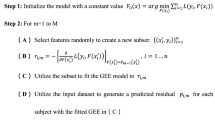Abstract
Longitudinal datasets contain repeated measurements of the same variables at different points in time, which can be used by researchers to discover useful knowledge based on the changes of the data over time. Monotonic relations often occur in real-world data and need to be preserved in data mining models in order for the models to be acceptable by users. We propose a new methodology for detecting monotonic relations in longitudinal datasets and applying them in longitudinal classification model construction. Two different approaches were used to detect monotonic relations and include them into the classification task. The proposed approaches are evaluated using data from the English Longitudinal Study of Ageing (ELSA) with 10 different age-related diseases used as class variables to be predicted. A gradient boosting algorithm (XGBoost) is used for constructing classification models in two scenarios: enforcing and not enforcing the constraints. The results show that enforcement of monotonicity constraints can consistently improve the predictive accuracy of the constructed models. The produced models are fully monotonic according to the monotonicity constraints, which can have a positive impact on model acceptance in real world applications.
Access this chapter
Tax calculation will be finalised at checkout
Purchases are for personal use only
Similar content being viewed by others
References
Ben-David, A.: Monotonicity maintenance in information-theoretic machine learning algorithms. Mach. Learn. 19(1), 29–43 (1995). https://doi.org/10.1023/a:1022655006810
Ben-David, A., Sterling, L., Tran, T.: Adding monotonicity to learning algorithms may impair their accuracy. Expert Syst. Appl. 36(3), 6627–6634 (2009). https://doi.org/10.1016/j.eswa.2008.08.021
Brookhouse, J., Otero, F.E.B.: Monotonicity in ant colony classification algorithms. In: Dorigo, M., et al. (eds.) ANTS 2016. LNCS, vol. 9882, pp. 137–148. Springer, Cham (2016). https://doi.org/10.1007/978-3-319-44427-7_12
Cano, J.R., Gutiérrez, P.A., Krawczyk, B., Woźniak, M., García, S.: Monotonic classification: an overview on algorithms, performance measures and data sets. Neurocomputing 341, 168–182 (2019). https://doi.org/10.1016/j.neucom.2019.02.024
Chen, C.C., Li, S.T.: Credit rating with a monotonicity-constrained support vector machine model. Expert Syst. Appl. 41(16), 7235–7247 (2014)
Chen, T., Guestrin, C.: XGBoost: a scalable tree boosting system. In: Proceedings of the 22nd ACM SIGKDD International Conference on Knowledge Discovery and Data Mining - KDD 2016, pp. 785–794. ACM Press (2016). https://doi.org/10.1145/2939672.2939785
Clemens, S., et al.: English longitudinal study of ageing: waves 0-8, 1998–2017 (2019). https://doi.org/10.5255/ukda-sn-5050-16
Duivesteijn, W., Feelders, A.: Nearest neighbour classification with monotonicity constraints. In: Daelemans, W., Goethals, B., Morik, K. (eds.) ECML PKDD 2008. LNCS (LNAI), vol. 5211, pp. 301–316. Springer, Heidelberg (2008). https://doi.org/10.1007/978-3-540-87479-9_38
Huang, G.B., Zhu, Q.Y., Siew, C.K.: Extreme learning machine: theory and applications. Neurocomputing 70(1–3), 489–501 (2006). https://doi.org/10.1016/j.neucom.2005.12.126
Kaiser, A.: A review of longitudinal datasets on ageing. J. Popul. Ageing 6(1–2), 5–27 (2013). https://doi.org/10.1007/s12062-013-9082-3
Martens, D., Baesens, B.: Building acceptable classification models. In: Stahlbock, R., Crone, S., Lessmann, S. (eds.) Data Mining. Annals of Information Systems, vol. 8, pp. 53–74. Springer, Boston (2009). https://doi.org/10.1007/978-1-4419-1280-0_3
Mo, J., Siddiqui, S., Maudsley, S., Cheung, H., Martin, B., Johnson, C.A.: Classification of Alzheimer Diagnosis from ADNI plasma biomarker data. In: Proceedings of the International Conference on Bioinformatics, Computational Biology and Biomedical Informatics - BCB 2013. ACM Press (2013)
Niemann, U., Hielscher, T., Spiliopoulou, M., Volzke, H., Kuhn, J.P.: Can we classify the participants of a longitudinal epidemiological study from their previous evolution? In: 2015 IEEE 28th International Symposium on Computer-Based Medical Systems. IEEE, June 2015. https://doi.org/10.1109/cbms.2015.12
Pijls, W., Potharst, R.: Repairing non-monotone ordinal data sets by changing class labels. Technical report, Erasmus University Rotterdam, December 2014
Pomsuwan, T., Freitas, A.A.: Feature selection for the classification of longitudinal human ageing data. In: 2017 IEEE International Conference on Data Mining Workshops (ICDMW). IEEE, November 2017. https://doi.org/10.1109/icdmw.2017.102
Ribeiro, C., Freitas, A.A.: A mini-survey of supervised machine learning approaches for coping with ageing-related longitudinal datasets. In: 3rd Workshop on AI for Aging, Rehabilitation and Independent Assisted Living (ARIAL), held as part of IJCAI-2019 (2019)
Ribeiro, C.E., Brito, L.H.S., Nobre, C.N., Freitas, A.A., Zárate, L.E.: A revision and analysis of the comprehensiveness of the main longitudinal studies of human aging for data mining research. Wiley Interdiscip. Rev. Data Min. Knowl. Discov. 7(3), e1202, March 2017. https://doi.org/10.1002/widm.1202
Verbeke, W., Martens, D., Baesens, B.: RULEM: a novel heuristic rule learning approach for ordinal classification with monotonicity constraints. Appl. Soft Comput. 60, 858–873 (2017). https://doi.org/10.1016/j.asoc.2017.01.042
Zhang, Y., Jia, H., Li, A., Liu, J., Li, H.: Study on prediction of activities of daily living of the aged people based on longitudinal data. Procedia Comput. Sci. 91, 470–477 (2016). https://doi.org/10.1016/j.procs.2016.07.122
Zhu, H., Tsang, E.C., Wang, X.Z., Ashfaq, R.A.R.: Monotonic classification extreme learning machine. Neurocomputing 225, 205–213 (2017). https://doi.org/10.1016/j.neucom.2016.11.021
Author information
Authors and Affiliations
Corresponding author
Editor information
Editors and Affiliations
Rights and permissions
Copyright information
© 2019 Springer Nature Switzerland AG
About this paper
Cite this paper
Ovchinnik, S., Otero, F.E.B., Freitas, A.A. (2019). Monotonicity Detection and Enforcement in Longitudinal Classification. In: Bramer, M., Petridis, M. (eds) Artificial Intelligence XXXVI. SGAI 2019. Lecture Notes in Computer Science(), vol 11927. Springer, Cham. https://doi.org/10.1007/978-3-030-34885-4_5
Download citation
DOI: https://doi.org/10.1007/978-3-030-34885-4_5
Published:
Publisher Name: Springer, Cham
Print ISBN: 978-3-030-34884-7
Online ISBN: 978-3-030-34885-4
eBook Packages: Computer ScienceComputer Science (R0)




